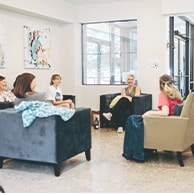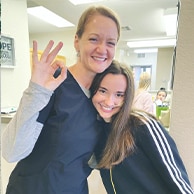Is there CRPS Clinics close to me?:
At this time, the only place in the world that offers our patented system is located in Fayetteville, Arkansas. For this reason, most of our patients travel to our clinic to enter our program. Our system is very complex and our staff undergoes rigorous training. While our long-term vision involves other locations, we are currently focused on expanding our existing location only.
How do I know if your CRPS Treatment Program can help me?:
We understand that many people who turn to us for help have been disappointed many times before, and therefore, we try to do everything in our power to ensure that our center is a good fit for you. The only way to know for sure whether your body will respond to our system is to physically start our program. Most of our patients see changes within weeks, not months. While we cannot guarantee a successful outcome for anyone, the number of people that have achieved CRPS remission in our clinic is unheard of.
What if I've been sick too long?:
We do not find that the length of time that you have suffered will affect your outcome adversely. We have had successful outcomes in patients who have suffered from CRPS for 30+ years.
What is your success rate treating CRPS condition or other conditions?:
While we cannot guarantee any kind of specific success rate, we see many success stories and we try to share that on social media as often as possible. The definition of success is different for every person. Some people experience complete CRPS remission and some people find that it is now possible to lead a fairly normal life with manageable pain levels.
Is there a cure for CRPS?
Is there a cure for complex regional pain syndrome (CRPS)? This is an extremely subjective and sensitive topic. When the word "cure" is used, that brings to mind visions of a miracle pill, injection, surgery, or perhaps a promising double-blind study excitedly announced by the media. Please believe me when I tell you that it probably won’t happen that way. The failure in finding such a "CRPS cure" lies in the theory of what CRPS is or what it is caused by. It is a complex problem, not a puzzle with a single solution. It is not a condition that can be healed by a miracle chemical; it is a body where a whole bunch of things went wrong.
CRPS must be approached by a method where every system involved is checked and rebuilt, if necessary, in a systematic way. We have known hundreds of patients and acquaintances who consider themselves healed from the neurologic symptoms of CRPS. If even one patient can do it, why can't you?
How is your process different from Complex regional pain syndrome management or suppression of pain?
Our treatment process is not focused on managing nor suppressing pain. We do not feel like that approach is a permanent sustainable solution. The goal of our treatment is to rehabilitate the Central Nervous System, allowing the body to heal from within. You are not broken beyond repair. Your body is amazing and capable of healing!
What are the stages of CRPS?
While CRPS was considered in the past to have three stages, it is now believed that patients with CRPS do not necessarily progress through these stages, or progress sequentially.
CRPS Stage 1 is characterized by intense, burning pain at the site of injury. Muscle spasms, joint stiffness, swelling, restricted mobility, vasospasms, rapid nail and hair growth, decrease in temperature, and decreased range of motion have all been reported. This has also been called "wet CRPS" as some patients may experience increased sweating. For a few lucky patients, this stage may last for a few weeks and then resolve on its own. For the unlucky majority, it progresses.
CRPS Stage 2 is characterized by even more intense pain, described by some as similar to the sensation of burning alive or being burned with a blowtorch. Hair growth is inhibited; swelling spreads; osteoporosis becomes severe; nails may crack, pit, grooved or have spots on them; joints tend to thicken, and the muscles will atrophy or shrink, causing the affected limb to appear thinner than the other.
CRPS Stage 3 is characterized by permanent changes in the skin and bones, while the pain becomes even more intense and now may involve the entire limb. Flexor tendon contractions may be present causing the limb or appendage to contract (much like a claw). The symptoms may spread to any other body part, for example the optic nerves or the digestive system.
Complex Regional Pain Syndrome diagnosis: The importance of correctly diagnosing CRPS with a doctor who specializes in CRPS / CRPS Expert
It is very difficult to find a doctor who is knowledgeable in recognizing and correctly diagnosing CRPS. Except for the lucky few, most CRPS patients may go many months or even years before they are correctly diagnosed with CRPS. If caught early, before brain, nerve and tissue changes set in, it is much easier to treat CRPS. For this reason, it is a true tragedy that some patients have to fight so hard to obtain a proper diagnosis. Although there is no one single definitive test for CRPS, there are a few things doctors look for when diagnosing this condition, and tests that help them to do so. If a patient is lucky, they will cross paths with a doctor well-trained in the diagnosis and treatment of CRPS (most often a CRPS neurologist or anesthesiologist).
If a physician or physical therapist is not familiar with spotting and/or treating CRPS patients then serious problems and setbacks can sometimes result. CRPS is one of those diseases where doing the wrong thing is often worse than doing nothing. As I mentioned above, the first year after the symptoms of CRPS first present themselves is like a golden window, as it is much easier to beat CRPS into remission during this period. After time goes by, certain physiological and anatomical changes make it a bit more challenging to beat the monster.
Diagnosis of CRPS is based on a physical exam and your medical history. Again, there’s no single test that can definitively diagnose CRPS, but the following procedures may provide important clues:
-- The Three-Phase Bone Scan
-- X-Rays
-- Thermogram
-- Neurologic Tests, which typically involve electromyography (EMG) and and nerve conduction techniques that measure major motor or sensory nerve changes.
-- Physical Exam
How does CRPS develop? What causes CRPS?
While stress (physical, emotional or chemical) causes all disease, it is our belief that CRPS is not the result of one single event or stress, but more like a complicated puzzle, made up of different parts. Stress only affects you adversely physically if you cannot adapt to it. People who suffer from CRPS became overwhelmed to the point that their bodies could not adjust or respond to stress, and CRPS was the unlucky result. Our patients, for whatever reason, (most of the time it is chronic viral infections or childhood trauma) had an imbalanced nervous system prior to developing CRPS. The triggering event is not the cause of the CRPS – it’s just the "straw that broke the camel's back" allowing symptoms to appear.
CRPS Type 1 vs CRPS Type 2 - What's the difference?
CRPS is associated with imbalance and malfunction of the autonomic nervous system resulting in disability, impairment, chronic pain, and functional loss. The International Association for the Study of Pain has proposed dividing CRPS into two types.
CRPS Type I, or CRPS Type 1, formerly known as Sudeck’s atrophy or reflex sympathetic dystrophy (RSD) does not exhibit demonstrable nerve lesions. The vast majority of people suffering from CRPS have this type.
CRPS Type II, or CRPS Type 2, formerly known as causalgia, has obvious nerve damage present. As a rule, type II is considered the more painful of the two types with an unenviable 47/50 score on the McGill pain scale.
Whether you have CRPS type 1 or type 2 treatment modalities at Spero Clinic are adapted and tailored to each specific patient, so each patient will receive a personalized CRPS treatment plan tailored to his or her needs. Contact Spero Clinic today for your FREE consultation.
 Spero Clinic Patient Graduations Ring Bell CRPS Josilynn
Spero Clinic Patient Graduations Ring Bell CRPS Josilynn Spero Clinic Patient Graduations Ring Bell CRPS FND Lauryn
Spero Clinic Patient Graduations Ring Bell CRPS FND Lauryn Spero Clinic Patient Graduations Ring Bell CRPS EDS Fibromyalgia Gastroparesis Raynauds Veronica
Spero Clinic Patient Graduations Ring Bell CRPS EDS Fibromyalgia Gastroparesis Raynauds Veronica Spero Clinic Patient Graduations Ring Bell CRPS Beatrice
Spero Clinic Patient Graduations Ring Bell CRPS Beatrice Spero Clinic Patient Graduations Ring Bell CRPS Abdul
Spero Clinic Patient Graduations Ring Bell CRPS Abdul Spero Clinic Patient Graduations Ring Bell Bilateral Atypical Trigeminal Neuralgia Stephanie
Spero Clinic Patient Graduations Ring Bell Bilateral Atypical Trigeminal Neuralgia Stephanie





